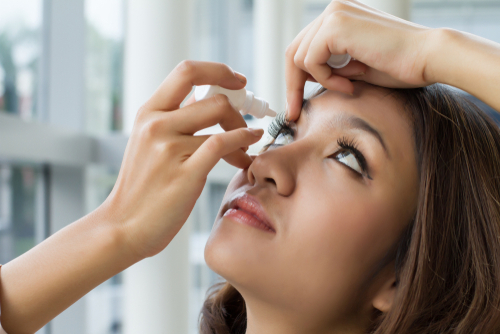Posted by: Eye Health Northwest in Dry Eyes on April 27, 2022

If you have dry eyes, it is likely that you experience irritation, tearing, and burning in your eyes throughout your day. The best way to manage your symptoms is to visit your eye doctor for a thorough evaluation and treatment plan.
Keep reading to learn the keys to dry eye management and treatment!
What Is Dry Eye?
Dry eye occurs when your eye cannot produce enough tears or tears of adequate quality to maintain eye health. Dry eye management aims to support quality tear production and provide lubrication when natural tears are insufficient.
You may be able to manage dry eye symptoms on your own initially. However, eventually, treatment by an eye care professional may be necessary.
Not all tears are created equal. Good quality tears have enough lipid or oil to lubricate the eye’s surface.
Meibomian glands produce lipids in the eyelid. Lipids prevent evaporation of the eye’s natural moisture.
When the meibomian glands are blocked, they don’t produce enough lipids to protect the eye. An oil insufficiency in tears will worsen their quality, causing increased tearing, a gritty feeling, and eye discomfort.
MGD, or meibomian gland dysfunction, is one of the most common causes of dry eye.
Dry Eye Management of Milder Cases
There are several methods you can try to improve your symptoms if you have a milder case of dry eye. It is best to ask your eye doctor which treatment they recommend.
Lubricating Eye Drops
Over-the-counter artificial tears are often the first thing most people turn to in an effort to improve dry eye symptoms. These fluids supplement your own tears and help keep your eye moist and ease discomfort.
Staying Hydrated
Drinking water throughout the day will hydrate you and your eyes. It’s a good thing for your eyes and your whole body.
Frequent Blinking
You naturally blink less when you’re on a computer or mobile device. Without frequent blinking, your eyes will dry out.
Take frequent breaks away from your screen and stop work to blink for a few seconds.
Warm Compresses
A simple home remedy is heat and moisture from a washcloth soaked in warm water and applied to your eyes. It can help release those essential lipids that keep your eye moist and prevent evaporation.
Eyelid Scrubs
Keeping your eyelids clean and free of debris and crusty deposits can help improve your symptoms. Especially if you wear eye makeup, thoroughly scrub your eyelids and between your eyelash follicles.
Over-the-counter cleansing eye gels and eye wipes can soothe your eyelids and scrub away build-up that can worsen dry eye.
Dry Eye Vitamin Supplements
Dry eye vitamins typically contain omega-3 fatty acids and other vital nutrients that support the production of lipids by the meibomian glands. Your eye doctor may also recommend increasing your flaxseed oils and fish oil intake.
Always check with your healthcare professional before adding any new supplements to your diet.
Dry Eye Treatment at EyeHealth Northwest
Once discomfort with dry eye interferes with your daily life, EyeHealth Northwest’s dry eye specialists will discuss treatments that can help.
Punctal Plugs
Punctal plugs are tiny silicone plugs inserted into the tear ducts to block drainage. These devices can improve your eye’s tear film, which enhances surface moisture.
Prescription Medications
When over-the-counter drops do not improve your symptoms, your eye doctor may recommend starting prescription eye drops. These drops can decrease eyelid inflammation and stimulate tears.
The LipiFlow Thermal Pulsation System
The LipiFlow treatment is a single procedure that removes blockages in the meibomian glands. By heating them from the inside, blockages are liquified.
Gentle pressure applied outside the lid removes the liquified blockages and flushes dead cells away. The LipiFlow treatment can help your eyes to resume their natural production of protective lipids.
Are you interested in learning more about the keys to dry eye management and treatment? Schedule an appointment at EyeHealth Northwest in Hillsboro, OR, today!

